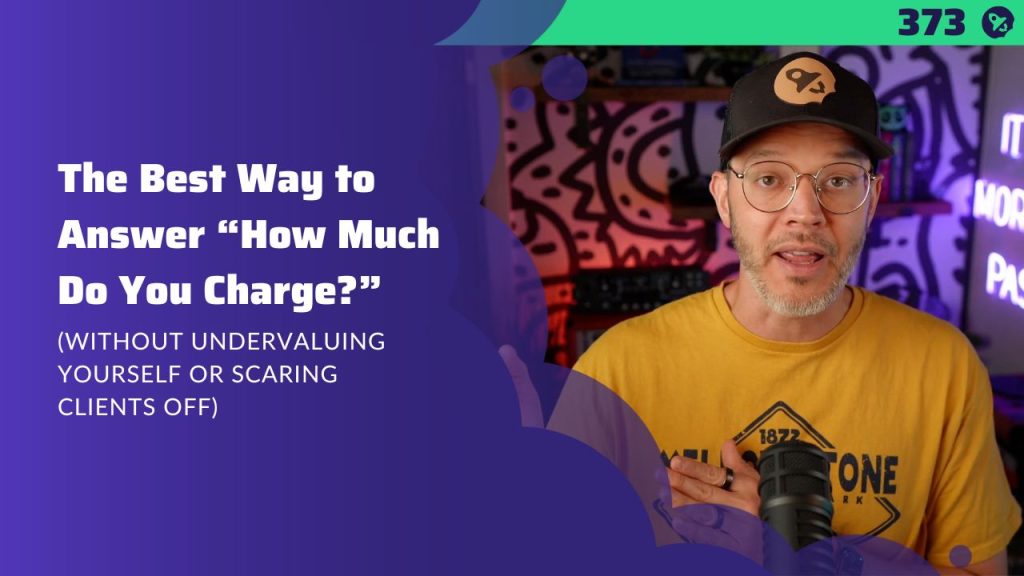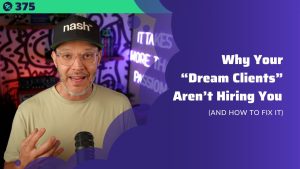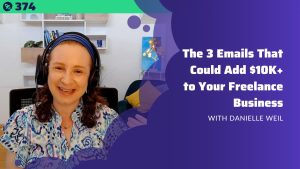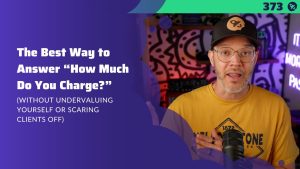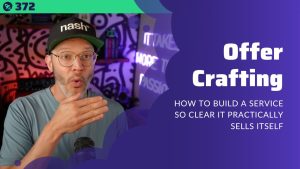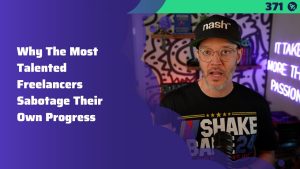- The 4 scenarios where you never give a number
- My actual templates you can use to stay in control
- How to filter out bad-fit clients without scaring off the good ones
If you’ve ever fumbled this question (or avoided it completely), this is the episode that will fix it.
Join The Discussion In Our Community
Click here to join the discussion in our Facebook community
Click the play button below in order to listen to this episode:
Episode Links
Apply for coaching now!
Brian's 4 Scripts:
- If the lead asks early (no info shared yet):
- “Great question! I’d love to get you a quote. Would you mind if I ask a few quick questions to make sure we’re talking about the same thing?”
- Good for most freelancers who want to have a conversation b4 spitting out numbers
- “Great question! I’d love to get you a quote. I have a quick form that helps me gather all the info I need from you. It only takes a couple minutes to fill out, and then I can follow up with pricing.”
- Great for in-demand freelancers who want to filter for quality OR literally have to have all this info for pricing
- “Great question! I usually price by ____ (hour/day/flat retainer/per song/whatever). It keeps things simple and clear. But before I jump into numbers, can I ask a couple quick questions about what you're looking for, just to make sure it’s actually the right fit?”
- great for butt-in-seat freelancers who need to get to pricing quicker but also want to have a conversation.
- “Great question! I’d love to get you a quote. Would you mind if I ask a few quick questions to make sure we’re talking about the same thing?”
- If the lead insists on a number:
- “Totally understand. Projects like yours usually start around [$X] and go up depending on the scope. Can I ask what you’re hoping to get done so I can give you a more accurate quote?”
- Good for when you do know ballpark numbers and aren’t afraid of weeding out tire kickers.
- Usually if someone insists at this point, they’re either a red flag client, or you’re a butt-in-seat freelancer and they’re just getting preliminary numbers.
- “Totally understand. Projects like yours usually start around [$X] and go up depending on the scope. Can I ask what you’re hoping to get done so I can give you a more accurate quote?”
- If you truly can’t price yet:
- “To give you a real number, I’d want to get clearer on the project goals and timeline. If you can fill out my inquiry form, I’ll have all the info I need to give you a quote. ”
- good for when you’re truly bespoke or semi custom projects and have no ballpark numbers to give (or don’t want to give them).
- Just stand firm with insisting they fill out your inquiry form.
- Remember, you don’t owe anyone an immediate number.
- good for when you’re truly bespoke or semi custom projects and have no ballpark numbers to give (or don’t want to give them).
- “To give you a real number, I’d want to get clearer on the project goals and timeline. If you can fill out my inquiry form, I’ll have all the info I need to give you a quote. ”
- If you offer packages:
- “I work off a few different packages depending on your goals. I can send over a breakdown once I know a bit more about your needs. Does that work?”
Companies
Social Media
Send Us Your Feedback!
373. How Much Do You Charge?
===
[00:00:00]
Brian: how much do you charge? This is kind of a scary question. We get this in our inboxes all the time, whether it's a dm, whether it's a text, whether it's an email. Whether it's in person even worse, and because of there being so much money junk in our heads as creatives, so much self-doubt as creatives, when we get this question, that's when the insecurity starts to creep in.
Brian: That's where the desperation sets in. That's where the fear of missing out takes over our logical brains and we start doing stupid things.
Brian: Stupid things like answering the question on the spot without any context. Stupid things like throwing out a number without understanding any of the scope of the project.
Brian: Stupid things like undervaluing yourself and pricing too low because you're scared of scaring the client away so you because of fomo.
Brian: Stupid things like rambling or sounding unsure, which is very common in in-person scenarios where someone asks your rates or asks how much you charge because you're insecure, you're scared, you have self-doubt.
Brian: This one question has killed so many deals for freelancers. It's triggered so many panic discounts, it exposed more unprepared freelancers than almost anything else,
Brian: And you end up underpricing yourself and you end up resenting [00:01:00] yourself and your clients because you underpriced and you're in this project for weeks and you're stuck and you don't know how to get out and you hate doing this.
Brian: and you question, why am I even freelancing? I could probably make more money getting a job somewhere.
Brian: and that's if you win the project, a lot of times you end up confusing the client so you lose the sale altogether,
Brian: or because you lost authority in the client's eyes. They went with another freelancer who was more confident, who understood how business is done,
Brian: worst of all, if you fuck this up, your client ends up hating you because you had to charge them more because you quoted them a price, actually the wrong price because you didn't have enough info about the project when you started,and then you realize, oh, I have to charge more.
Brian: And now your client hates you because now the price is up from what you told 'em at the beginning.
Brian: Obviously this is all bad. Obviously we want to avoid all of this and we can avoid all of this.
Brian: If we stop treating the, how much do you charge question, like it's a yes or no numbers only kind of question where you have to give a number, you have to give a price, you have to give something. you can treat this question just like a conversation starter.
Brian: It's a chance to lead the way, to show that you're professional, a chance to build a relationship. And I'm gonna walk you through exactly how to do that without feeling salesy, without feeling awkward, without feeling sleazy, [00:02:00] without losing the deal, without scaring people off, or at least not scaring the right people off you.
Brian: We wanna scare wrong people off.
Brian: And if you do it all the right way, you stay in control of the conversation. You project confidence and professionalism to the client, meaning now they respect you more. You give yourself room to price based on value and not time.
Brian: You avoid giving the wrong numbers. That led to the underpayment and over promise, which is what we don't want to happen.
Brian: and you build trust by showing your clients that you take their needs seriously.
Brian: That's what we're covering today. If you're new here. Hi, I'm Brian Hood. This is the six Figure Creative Podcast, feeling a little under the weather today. So I'm gonna be a little lower energy than usual, my bad. But I'm trying to get ahead for the summer because I'm going. As of the time this episode comes out, I'm actually probably just coming home from Europe,
Brian: but this podcast is for creative freelancers who wanna make more money without selling their souls. And to me, the ultimate soul selling thing you can do is underprice yourself over promise, under deliver. Hate yourself. Your client hates you. You wonder why you're even doing this. you go get a real job somewhere.
Brian: That's the ultimate soul selling
Brian: and the whole point of this podcast is to bring outside influencers from lots of different people, from lots of different industries, lots of different perspectives, not just [00:03:00] my own, in order to help you make more money.
Brian: and today we're discussing how does just answer this seemingly stupid simple question, how much do you charge? What are your rates?
Brian: Now, before I get into some different ways you can answer this, depending on the context. 'cause this is very contextual. Before I get into that, I wanna talk about a couple things I.First I wanna talk about the but seat spectrum. ' this matters in this conversation. And then I also wanna talk about the mindset shifts around this question because you need to shift your mindset around this before I can even tell you what to say, because you won't say it if you don't shift your mindset around this.
Brian: So first, the button seat spectrum. Basically the more button seats you are meaning. The more I can go on Fiverr and find someone who offers the exact same thing that you do, and I can put their butt in the seat and the outcome's gonna be roughly the same as what you do.
Brian: The more button seat you are, the more quickly you need to be willing to get to a price relatively quickly.
Brian: So if you button seat freelancers where you are just a button a seat, I'm not saying draw out this process. Make 'em go fill a bunch of hoops. Chances are you'll have to get to a price pretty quickly. But that does not mean that you're going to just spit out a price on command.
Brian: You're not just a dancing monkey spitting out numbers the second they ask for it.
Brian: But again, button seat is a spectrum. So you have the [00:04:00] extreme button seat, That's the basic video editor I can get on Fiverr or Upwork
Brian: where I have three dozen to choose from. And there's not much of a difference between them, other than a few small differences. That's very button seat. The other end of the spectrum is truly bespoke. Very transformational. And there's everything in between. So the more high end you are, the more transformation you are.
Brian: The more bespoke you are, the more you need to guard your price. And when I say guard your price, that just means there's more hoops to jump through to get to a price.
Brian: Now we'll talk about this a little bit as I get to the actual context and some of the things you can say in these scenarios, but that's just a blanket statement. a benchmark you can give yourself. Where on the spectrum do I live when it comes to button seat commoditized freelancing or truly bespoke transformational freelancing?
Brian: The second thing I wanna talk about before we get into the actual things to say is the mindset shifts around this question.
Brian: The first mindset shift is this. The pricing conversation is part of your positioning. It's part of your overall positioning, this entire conversation, this song and dance. And when I say positioning, it means it signals how professional you are, how organized you will be when you work with someone, what kind of clients you are for.
Brian: And if you don't know what I mean, you can just [00:05:00] visualize the positioning of a specific car, the Ford Focus versus the Ferrari, whatever those two cars are positioned for completely different types of customers, just like that. Freelancers position themselves for different types of customers, and this is one of many things Im positioning that will set you up for signaling yourself as a low level, freelancer or a high value freelancer.
Brian: So if you have a low price and a bad conversation around pricing, that means low budget, beginner, commoditized, freelancing. You don't wanna be there. Now on the higher price and the well ran pricing conversation, those two things together equals high value expert strategic partner, especially if you're a B2B.
Brian: If you're in some other niche, that's not B2B, you understand what I'm saying?
Brian: Now, you could technically be low price and run a really good pricing conversation. You could also be, again, there's so much context with business. I'm sorry, it's not black or white. You also could be high price, wonderful pricing conversation, but the rest of your positioning in your business is an utter mess.
Brian: Therefore they're confused. They don't know really where you sit.
Brian: It's like [00:06:00] putting the Ford Focus engine into a Ferrari. Now, what do you have? I don't really know. How much do you charge for that? What kind of buyer is for that? I don't know,
Brian: but the goal for right now. The only thing we can focus on in this episode, in this video, in this audio, however you're consuming this, the only thing we can focus on is how do you approach this conversation around pricing, because this is part of your positioning and it's an important part of it.
Brian: The second mindset shift around this conversation is, this question is not a demand. How much do you charge? It's not a demand from your clients. It is an invitation to lead. And when you take it as an invitation to lead, you are putting them through your process.
Brian: And I've talked about this on the podcast before. Every freelancer should have a process. It's how you do things. Even on the most button seat freelance position, you can have a process that you lead your client through that they have to trust you on. ' cause at a certain point, unless they're the worst micromanagers in the world, in which they should just be doing the service anyways, at a certain point, you are in a box working by yourself, and you have your process there you dictate the process.
Brian: The more bespoke you are, the more high-end you are. the better you are at your job, the bigger that box becomes of your process. I will [00:07:00] always, forever and ever. This podcast is for premium freelancers. This is not for button seat freelancers. I do not target beginners in ads. I do not target beginners in these episode topics.
Brian: I do not target beginners in anything I do. I target people who are already establishing their careers. two third of our audience is full-time. A third are like over six figures. So it's a really, really good audience that consume the show of the thousands and thousands of listeners that listen to the show weekly.
Brian: And so if that's our audience or you are maybe on the beginner end and you aspire to be, the more premium, the higher end, the person who's the expert, if that's you, you have to lead the show in these situations. And the more you rely on your client to lead the show, the more you're screwing yourself over.
Brian: Because remember, they're coming to you for a specific outcome. They're coming to you because you're good at what you do. If you're not good at what you do, go fix that first. They're coming to you because you're good at what you do, and when you're good at what you do, they have to trust you, that you know what you are doing.
Brian: And when you do know what you're doing and you're good at what you do, you create the boundaries for everything in the process. They give you the raw materials. They give you what you need in order to do [00:08:00] your thing, and you have your process for how you lead them through it, and your pricing conversation is part of that.
Brian: This is an invitation to start that leadership as a freelancer, and it could be very, very difficult. You're a B2B freelancer. You are working with bigger and bigger businesses. You are a music producer and you're working with bigger and bigger artists. You're a videographer. You're working with bigger, bigger productions.
Brian: And so as you as a freelancer, even as you get to six figures or multi six figures, it can still be intimidating to quote, run the show or lead it. When you're talking to a multi multi-million, a decade million dollar, a billion dollar business, I. We have clients working with people in the hundred plus million dollar range, and that can be intimidating, but it's still, you're working with one human within a large organization and you are the trusted expert for the domain that you have built for yourself.
Brian: So that's the second big mindset shift is this is not a demand, it is an invitation for you to lead the conversation. Through your process and the third mindset shift is kind of tied to, it's not a demand. The third is you don't owe a number to anyone, not an immediate number. You don't actually owe a number ever to anyone at any point.
Brian: You can give [00:09:00] prices out to whoever you want, whenever you want. It's your business, but especially in this context, you don't owe an immediate number to anyone because in most cases you need more context, especially the premium freelancing side. You need more context. In order to get more context, you have to ask questions.
Brian: So that leads us to the four different contexts I wanna talk about for this episode, which is most of the context that any of the freelancers listening to the show are going to come across.
Brian: And I'm just gonna give you basically a script to use. You can go to the six figure creative.com/ 3 7 3, and if my team has done their job, they'll have these four scripts on the show notes page.
Brian: or just sit there and type it out. Didn't take long. Adapt it to your needs. But the first context I wanna talk about is this. If the lead.
Brian: The person who's asking pricing if they ask early, which is almost always the case where there's no information shared yet. There's a couple different ways you can approach this,depending on the context. The first is this. Always acknowledge that. It's great question. I always just put something like, great question, exclamation point.
Brian: I use a lot of exclamations points. I'm a millennial. think boomers just use periods, gen ZI don't actually know what to use,but I'd like to show that I'm excited and this is a good question, so good question. I'd love to get you a quote. Would you mind [00:10:00] if I asked a few quick questions to make sure we're talking about the same thing?
Brian: and you can word that however you want. You can say, would you mind if I ask a few quick questions so I know more about the project? Or, so I know more about your needs or, so I know more about you, so I know more about your goals, whatever you wanna say there.
Brian: But this is a,good response for freelancers who want to have a conversation before just spitting out a number.
Brian: you can have that conversation in whatever meeting is. If it's in person, you're gonna say, sure, lemme ask you four more questions, if you don't mind, so I can know more about the project to even give you a price. Cool. If it's chat, if it's dm, you can respond back in that same chat. If it's the email, you respond back in that email.
Brian: It's very simple. The goal is to get a response from them continue the conversation. You're gonna see this as pretty much the case for every single one of these. You're trying to continue a conversation. In most cases, there's a couple cases where you're not, and this is actually the next case here.
Brian: the next, kind of template here is for when you're in really high demand as a freelancer,
Brian: when you're booked solid, when you're in high demand, when you couldn't take on more products or as one of our clients said, if I get another project right now, I'm gonna kill myself. you know what that means? He wasn't being serious. But it's just like when you're in one of those feast seasons where you have so many projects, this is how you can handle these sorts of situations so that you don't have a lot of tire [00:11:00] kickers.
Brian: Again, great question.
Brian: I'd love to get you a quote. I have a quick form that helps me gather all the info I need from you. It only takes a couple of minutes to fill out, and then I can follow up with pricing and then you link the form. This is how I handle it.
Brian: For most of my freelance career, I.When someone asked me a price, I used to call this the trigger point. The trigger point iswhat is the point in the,leads journey where you send them to your form so they can be entered into your CRM. Back then, I was, this is like 2014, when I first started using a CRM.
Brian: it was called close.io back then. It's now close.com. Still a good CRM. a big one. It's,used by a lot of people. I don't use it anymore. I think it's a little too manual for my liking, but. used it, it worked fine. But this trigger point is the moment where we get out of dms, out of texts, out of phone calls, out of in-person, out of, the billion different areas, you could have conversations.
Brian: And that's the second I consider them a,sales lead. they, they now go into my CRM and they get to my CRM by filling out this inquiry form.
Brian: In this case, you're not necessarily trying to have the conversation right there. You're trying to get them to fill out the form so they're now a sales lead or a lead in your CRM,
Brian: And this means now you have all the information [00:12:00] to make a decision. The decision is, are these people qualified? Do we even wanna work with 'em? If not, I let them know if they're qualified.
Brian: How am I gonna price this?
Brian: I'll let you in a little secret. I had a pain in the ass tax. A pet tax. That is when, if it's a client that I think is going to be a pain for whatever reason, I'll add a, surplus on top of what the initial quote would be. It's your business. You can run it however you want. You don't have to do that.
Brian: That's just how I did it. But that's the decision I could make. When I had all the information there right in front of me, I could decide, is this gonna be an absolute pain to do? And I'm gonna add that Pete attacks on top of that, and now this is the best part. Now that you have the lead, you can follow up with them until they say yes, until they say no or until they die.
Brian: One of those three things or until you die. Number four. And if you do that, you will make more money, period. It's a bet I'll take a hundred times out of a hundred that you will make more money if you follow up with every single lead who's qualified, who has not said no
Brian: and has not said yes, you fall up until they die.
Brian: Now, let's talk about the button seat freelancers. I'm not gonna leave you hanging even though I, this podcast is not necessarily for you. For you button seat free answers where you need to get to pricing a lot quicker. You also [00:13:00] wanna have a conversation. You don't wanna just spit out a price immediately.
Brian: How are we gonna start this answer out? You already know. Great question. Exclamation point. I usually price by insert, however you price here. Usually in button seat, you price by hour by day you have a flat retainer, you have a flat. Price per song, per video, per deliverable, per minute, per whatever.I usually charge by day.
Brian: I usually charge by song. I usually charge by hour. I usually charge by whatever. It keeps things simple and clear. But before I jump into the numbers, can I ask a couple of questions about what you're looking for, just to make sure it's actually the right fit? Simple, easy response. The good thing about this scenario is even if you're a button seat freelancer, you're getting a response from them.
Brian: At least you're starting some sort of conversation. You're getting a little more context about the gig. Chances are, whenever they respond back, if you have enough information, you're just gonna give the price after that. But it's better than just immediately shooting back the price to them.
Brian: Now let's get to the second context here. The first context is they pitch you up. What are your rates? You don't have any information from them. What do we say? That was that first context. Second context is what if they insist on a number? What if they're like, yeah, I, I can fill the form out, but [00:14:00] just gimme a number.
Brian: Gimme something. How much is it? Gimme, just gimme a fucking price.
Brian: And you kind of have a couple options here. First of all, I like to just say if someone insists on a price. means a couple things. One is it could just be a red flag client you don't wanna work with anyways, or you're just a button seat freelancer and they're just trying to get preliminary numbers.
Brian: They're trying to get some early numbers to get an idea for how much a project might cost. Totally fair. So just because they insist on a number doesn't mean they're a red flag client, but it does generally mean that the higher up the spectrum you go in freelancing. 'If I'm working with a high-end brand designer, a high-end brand designer that charges 50, a hundred, $150,000 for brand design, and I'm like insisting in the email or insisting in the DM or insisting in person that I get a number from them, right then.
Brian: I'm a red flag client. but I also just might wanna know a ballpark. I might be a good client and don't wanna waste your time as a freelancer. So that's where we get to this, response here. This is good for when you, you know, a ballpark price of what you typically charge.
Brian: You know, the ballpark numbers, not the specifics, but the ballpark. And you are not afraid of weeding out tire kickers.
Brian: you can say something like this. Totally understand. Projects like yours [00:15:00] usually start around $50,000 and go up, depending on the scope. Follow up with a question. Can I ask what you're hoping to get done so I can give you more accurate quote, or next steps would just be to fill out the form so I can give you an accurate quote.
Brian: at the very least in this situation, you've given the ballpark number so they can just go away if they're not a good fit for you. This is, especially for those of you who are busy.
Brian: But what happens if they insist on a number, but youtruly can't price it. You are like truly bespoke. Maybe even not a give a ballpark number even,or you just have very custom, semi-custom projects. Or if it bespoke, semi-custom and you just don't want to give a ballpark number,
Brian: here's your response for that scenario. For this kind of context, to give you a real number. I need to get clear on the project goals and timeline, or I need to get clear on X, Y, and Z. Whatever your actual criteria are, if you can fill out my inquiry form, I'll have all the info.
Brian: I need to give you a quote, no ballpark number given, no price point given you've pushed 'em again to your courtrequest form your inquiry form
Brian: One more small caveat to this. If you are a bespoke or a semi-custom type freelancer, we need a lot of information. But you are in kind of desperation mode for clients. You can just [00:16:00] simply ask them all the questions that are in your inquiry form right there. How many songs, where can I see your music, see your portfolio, hear your work whatever your niche is. Got a lot of different niches listening to this podcast, but you can ask 'em all the questions that are in your inquiry form right then and there to make it easier for them to remove the friction, including their email address, so you can follow up, you can put them in your CRM, you can have all your follow up reminders.
Brian: You can even automate some follow ups, in some cases, in some CRMs, so you don't necessarily have to push 'em off to a court request form in this scenario.
Brian: And one more just kind of context I wanna throw in here. for those of you who offer standard rates, standard retainers, you offer a package or packages, kinda a flat rate thing, especially for packages. Something like this, they wanna know price.
Brian: You can say I work off a few different packages. Depending on your goals, I can send over breakdown. Once I know a bit more about your needs. Does that work?
Brian: Notice how you're ending with a question here. Trying to get a response for them.
Brian: If the goal with all these responses is pretty much the same, either turn it into a conversation, get a response, or get the lead one of the two, the conversation is more back and forth, more tit for tat, getting to know you, answering some questions. It helps build trust, it helps get to know each other.
Brian: They will not hire you if they don't [00:17:00] like and trust you basically, and this is aone of many chances to get them to know, like, and trust you. The better chance is to get on a full discovery call. So in my ideal sales process, for almost every premium freelancer, it's inquiry form. You figure out if they're a good fit or not.
Brian: Do a discovery call. Figure out the full scope of what they need, talk pricing on the discovery call, follow up with a proposal if necessary, just a summary of what you talked about on the call. That's generally the process. Sometimes you need multiple calls. You need to talk with decision makers, et cetera.
Brian: But if you remember nothing else from this episode, it's this. You don't have to answer how much you charge with a number right away. You can take control. You can lead the conversation. You can show them that you're a pro and then run them through your process.
Brian: This entire like, quote pricing question. The pricing question is just one small part of your entire sales process. the sales process involves a lot of things. I'll just talk through some of it from how you qualify people to your pre-call questionnaire, your inquiry form questions to how you run your discovery calls, to how you follow up, what you say when you follow up, how often you follow up, how long you follow up for, to how you talk numbers and pricing, how you even price yourself, how you handle objections [00:18:00] again.
Brian: This is just one tiny little piece of your overall sales process. What CRM do you even use? Do you even use the CRM and your sales process? This bigger box that contains all of these sales things is just one of five major massive parts of your client acquisition machine as a whole. So there's a lot you need to know and that you need to get right. If you wanna land more clients, which on the inverse, that means there's a ton that you can mess up that are pushing clients away from you constantly. Now, I've got a ton of content on this podcast. I launched this podcast like late 2017, early 2018.
Brian: I don't know, 2018, maybe there's 372 other episodes on this podcast where you can binge through and learn a ton about anything in the sales process, the generation process. Pricing packaging offers, qualifying leads. getting rid of red flag clients. We have a ton on the show, but if you don't wanna do this alone or you don't trust yourself to do this alone because you've had a history of just edutaining yourself going through education to entertain yourself and not actually do anything with it, or you just wanna drastically speed this up,how quickly you're doing in implementing these things, here's how we can [00:19:00] help you.
Brian: We have a client acquisition coaching program called Clients by Design. The way it works is we will design and develop an entire client acquisition strategy custom to your needs and your business based on what is missing from your business, based on what you're doing now that is broken
Brian: or based on what you're doing now that you shouldn't be doing or ever doing.And we will pitch that entire strategy to you. You can decide, do I like the strategy or not? If you do not like it, we part ways. We never work together. You don't owe us anything. You're out $0. If you do like the plan, we'll implement you through coaching iton a month to month coaching program that you can cancel anytime.
Brian: And we have resources and playbooks, we have templates and software. We give you a full CRM with all the stuff built out on it,
Brian: And you can cancel it any time. It is a month-to-month coaching program with no long-term contracts. So if you want to apply for it, to see if you're a good fit, just go to six figure creative.com/coaching, fill that short application out and then, we'll look over it and we'll see if you're a good fit.
Brian: If you are, we'll talk you through it. If you're not a good fit, we'll let you know. So let's all go out for you today. Try to get my energy back again. Feeling a low with weather. right now I've got one of my team. here from New [00:20:00] Zealand, and I think he brought him something over on the plane that he gave me.
Brian: I'm gonna go rest up, have lunch, and then I still got a nice day ahead of me. So thank you so much for listening to the six Figure Creative Podcast. Peace. I'll see you next week.
Sign up to receive email updates
Enter your name and email address below and I'll send you periodic updates about the podcast.

